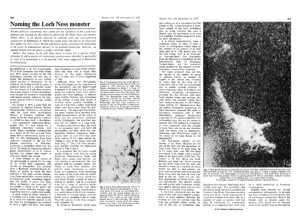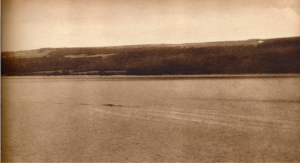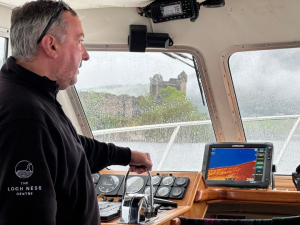On 11 December 1975, Nature magazine published one of the most unusual articles in its long history. In a piece signed by the naturalist Sir Peter Scott and the multi-talented Robert Rines, the Loch Ness Monster was given its scientific name: Nessiteras rhombopteryx. Unsurprisingly, the publication unleashed a storm of controversy. But far from being a joke or a mad rant, the article had a purpose: if there was any chance that Nessie really existed, it needed a proper name to protect it from extinction.

The story has its origins three years earlier, although in reality it dates back to the year 565, when the Irish monk Saint Columba is said to have summoned the power of God to drive a beast back into the River Ness. However, it is often said that this episode and other ancient accounts were not actually associated with the famous Scottish loch monster until 1933, when the current legend took shape through at least three separate sightings. Since then, the legend has been kept alive by more than 1,100 recorded accounts, including elaborate hoaxes, and always without any clear evidence.
The first sighting
In 1972, American inventor, lawyer and musician Robert Rines was on his honeymoon in Scotland when he spotted in Loch Ness what he described as “a large, darkish hump” with “rough, mottled skin, like the back of an elephant”. The sighting lasted for over 10 minutes. Rines was not a credulous man and had a scientific background. He himself admitted that the idea was ridiculous and that if he had not seen it with his own eyes, he would have thought he was crazy: “I may not be able to prove it, but I know there was a plesiosaur in Loch Ness because I saw it.” In fact, his interest in the monster was born even before that episode.

Recruiting a team of experts and equipped with some technical resources, Rines organised numerous searches of the loch over the next 35 years. In 1975, he announced the first major fruit of his work, a series of underwater photographs that appeared to show a triangular fin 1.5-2 metres long, along with what appeared to be an elongated neck, a bulging body and even a head, all resembling the prehistoric plesiosaur that Rines claimed to have sighted. With the collaboration of the ornithologist and painter Sir Peter Scott, the only son of the famed polar explorer Robert Falcon Scott, who had co-founded a research group on the monster ten years earlier, the alleged find achieved great resonance, capped by the appearance of the article in Nature, which was not published as a peer-reviewed study but as a news item or commentary.
The two authors assigned Nessie a genus and species, Nessiteras rhombopteryx, meaning “Ness monster with diamond-shaped fins”. The article specified the purpose of this designation: a new conservation law in the UK at the time required that protected species be given a proper scientific name. Rines and Scott therefore hoped to have the creature listed as an endangered species. However, the text did not merely attempt to describe its anatomy, but also speculated on its origin: a population that became land-locked some 12,000 years ago; its numbers: a viable population that could be less than 30 individuals; and its diet: mainly fish, including salmon.
A finding in The New York Times and further explorations
Naturally, Rines and Scott’s hypothesis was met with strong scepticism, with alternative interpretations of the images proposed: a boat, a diver, or just fish. But the biggest threat to the credibility of the two authors came when, just days later, The New York Times published a more than suspicious finding by Scottish MP Nicholas Fairbairn: the scientific name assigned to Nessie was an anagram of “Monster hoax by Sir Peter S.” And yet Rines quickly and cleverly countered with a different anagram: “Yes, both pix are monsters—R.”

But if Fairbairn’s objection could be a mere coincidence, Rines’ images have not stood the test of time. In 1984, researcher Ronald Binns suggested that the images had been enhanced in such a way as to show something not visible in the originals. This was later confirmed by marine biologist Adrian Shine and Dick Raynor, who was part of the Rines expedition. In 2002, Raynor concluded that the photos had been retouched and that the rhomboidal marks were just impressions made by the camera on the lake bottom. Rines himself admitted that the images may have been manipulated by the journal.
Explorations of the lake have continued to this day, but always without success, and the authenticity of the various alleged photographic evidence has been found wanting. For his part, Rines never gave up. In 2008, he undertook his final search, just a year before his death—Scott had died in 1989—but he said then that he only hoped to find a skeleton: in his opinion, Nessie was already extinct, another victim of global warming. “What am I supposed to do—forget what I saw?” he said at the time. “There are a lot of eyewitness accounts. Are they all liars? All drunks? I don’t believe human nature is like that.”
Javier Yanes
Comments on this publication